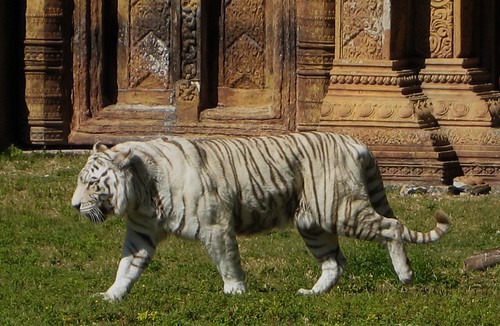Watch this white tiger found in captivity, in Miami MetroZoo, spread over 740 acres (3.0 squire km), is the largest and oldest zoological garden in Florida. It is located in southern unincorporated Miami-Dade County southwest of the city of Miami and west of the village of Palmetto Bay. It houses over 1,200 wild animals and is the only subtropical zoo in the continental United States.
Monday, February 22, 2010
White Tiger in Miami Metrozoo
Saturday, February 13, 2010
Jim Corbett
Photo: Jim Corbett with the slain tiger, Bachelor of Powalgarh
Jim Corbett (Edward James Corbett), born on 25 July 1875 in Nainital in the Indian State of Uttarakhand, was a hunter of Irish ancestry. He was a conservationist, naturalist, photographer and writer famous for killing a large number of man-eating tigers and leopards that had killed people in the villages of the Garhwal and Kumaon regions in India.
According to Wikipedia, though Jim Corbett held the rank of colonel in the British Indian Army and worked for the Bengal and North Western Railway, often he was called upon by the government to slay man-eating tigers and leopards. According to records, between 1907 and 1938 Corbett had shot dead man-eaters such as the Champawat Tiger, the Leopard of Rudraprayag, the Tigers of Chowgarh and the Panar Leopard. These man-eating big cats, 19 tigers and 14 leopards, had killed more than 1200 men, women and children.
As he had great admiration for tigers and leopards, he resolved never to shoot them unless they turned man-eaters or posed threats otherwise. However, by his own account, Corbett had shot the wrong animal at least once, and he greatly regretted the incident. Man-eaters are quite capable of stalking the hunter. So Corbett preferred to hunt alone travelling on foot while pursuing dangerous game. At times, Corbett took dangerous personal risks to save the lives of others.
Corbett was deeply concerned about the fate of tigers and their habitat. So he used to lecture to groups of school children about natural heritage, the need to conserve forests and wildlife. Along with F. W. Champion he played a key role in establishing India's first national park, the Hailey National Park in the Kumaon Hills. Later the park was renamed in his honour as Corbett National Park by the Indian government in 1957.
In 1968, one of the five remaining subspecies of tigers, the Indochinese Tiger, which was also called Corbett's tiger, was named after him as Panthera tigris corbetti. The famous books written by Corbett are: Man-eaters of Kumaon, The Man-eating Leopard of Rudraprayag, My India, Jungle Lore, The Temple Tiger and more man-eaters of Kumaon, Man against man-eaters, and Tree Tops.
After 1947, Corbett and his sister Maggie retired to Nyeri, Kenya, where he continued to write and sound alarm about declining numbers of jungle cats and other wildlife. After retirement, Corbett authored the Man-Eaters of Kumaon, Jungle Lore and other books recounting his hunts and experiences. He also advocated for the protection India's wildlife from extinction.
Jim Corbett died of a heart attack after he finished writing his sixth book Tree Tops, and was buried at St. Peter's Anglican Church in Nyeri.
Tuesday, October 20, 2009
Sumatran Tiger, Indonesia
Sumatran tiger (Panthera tigris sumatrae), the smallest of all surviving tiger subspecies, is found in the island of Sumatra in Indonesia. Its stripes are narrower than the stripes of other subspecies of tigers and it has a more bearded look with a mane. It has webbing between its toes that makes Sumatran tigers very fast swimmers. The Sumatran Tiger is genetically isolated from other mainland tigers. According to estimates, at present there are only 100-400 Sumatran tigers left in the wild natural habitats.
Monday, September 28, 2009
Bengal Tiger in Kerala
The author who loves wildlife photography, clicked this photo when he was working with Kerala Government's Forest Department.
Wednesday, July 29, 2009
Tigers vanish from Indian tiger reserves



There are 37 tiger reserves in India. But two of the tiger reserves, Panna in MP and Sariska in Rajasthan have visibly no tigers now. There is no reliable information available on the number of tigers in seven other tiger reserves. These seven tiger reserves also will go into the list of tiger reserves without tigers if immediate steps are not taken. This information came out at the All India Meet for Tiger Reserve Directors in Sariska.
Speaking at an interactive session on the fate of Indian Royal Bengal tiger, Indian Minister of State for Environment and Forests Jairam Ramesh asserted on July 28 that innumerable instances of poaching of wild animals, particularly the majestic striped felines like the tiger, pose a serious threat to India’s entire ecosystem. He said instead of trans-locating the tigers, poaching needs to be curbed.
"Between the years 2002 to 2004 around 23 tigers were poached in Sariska National Park. At present we have trans-located three tigers from Ranthambhore. But trans-location is not the solution. We have to fight against poaching. Today poaching is the biggest threat," Jairam Ramesh said.
National Tiger Conservation Authority (NTCA) Member Secretary Rajesh Gopal admitted that one of the tiger reserves, Indravati in Chhattisgarh, where “tiger protection efforts in the past 20 years have failed”, should be denotified.
The other tiger reserves facing the extinction of tigers are Simlipal in Orissa, Palamau in Jharkhand, Manas in Assam, Namdapha in Arunachal Pradesh, Dampa in Mizoram, Buxa in West Bengal and Valmiki in Bihar.
The Royal Bengal tiger (scientific nomenclature: Panthera tigris tigris or Panthera tigris bengalensis), is the most populous subspecies of tiger mainly found in India and Bangladesh, in addition to parts of Nepal, Bhutan and Myanmar.
There were 40,000 tigers in India at the beginning of the last century. In 2006, when the last tiger count was made, about 1411 wild tigers were reported by the Government of India's National Tiger Conservation Authority. Since then about 100 tigers have died because of poaching, natural reasons and man-animal conflicts.
In the last few months not even one of the 12 tigers believed to be in Buxa in Jaipalguri district (West Bengal) was spotted.
Manas had 40 tigers in 2006 but the tiger population is dwindling due to deforestation and poaching. Four tiger deaths were reported in 2009 from Manas.
Valmiki in Bihar had 10 tigers in 2006. This year poachers from Nepal have been very active in the reserve that has seen very poor conservation efforts.
Simlipal in Orissa had 40 tigers in 2006, but in 2008-09 it was reduced to two tigers per 100 sq km from the ideal two tigers per 10 sq km; poachers have been caught on camera killing prey.
Indravati in Chhattisgarh has made no estimate of tiger population in the last nine years. In 2000, the reserve had 100 tigers. But now doubts are being expressed about possible killing of a substantial numbers of tigers by Naxalites to raise funds.
Palamau in Jharkhand had no census of tigers in 2006. Poaching is rampant in the vicinity of the tiger reserve.
Namdapha in Arunachal Pradesh had 12 tigers in 2006, but no tiger was spotted in the past 12 months.
The above is part of the impressive statistics presented at the All India Meet for Tiger Reserve Directors. There are reports about India facing difficulties in controlling illicit trade in tiger organs, tiger bones, tiger skin and products and this has been brought to the notice of CITES (Convention on International Trade in Endangered Species of Wild Fauna and Flora) time and again, according to reports.
India is the home to about 50% of the world's tiger population. The Bengal tiger is the second largest subspecies after the Siberian tiger. The tiger species Panthera tigris is the national animal of India. The tiger subspecies Panthera tigris tigris is the national animal of Bangladesh.



